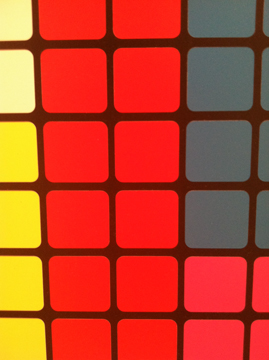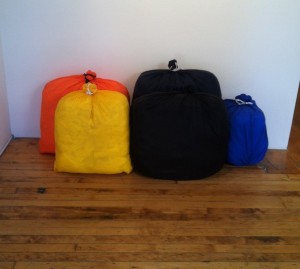Slyvan Lioni @ Kansas Gallery
I plop down on the gallery floor in a fat scalene triangle of afternoon light. The door to the street is propped open and I can feel a little breeze. I want to be eye level with this artwork: five nylon sacks stuffed with what? Hmmm. They don’t smell, so if it’s laundry that’s in these bags it’s not dirty. Perhaps whatever’s inside is less significant than the function this mystery material performs—accentuating the sacks’ physical forms. Yes, perhaps, because once form is established you can start creating structures and systems, developing matrices where color and shape might approach tangibility through recognizable patterns. If that’s the case then the next question is what these patterns might signify?
To my right three sheets of paper are thumbtacked to the wall, a legal-size sheet sandwiched by a pair of smaller letter-sized pieces. Each is painted, though not in a way that reveals brushstrokes. The coats of paint are dead even and new-car smooth, mechanical looking really, a degree of technical perfection held in balance by the crimp, crease, and crinkle of the paper itself. Wait a minute, something suspicious about these paper sheets; when I blow on them they don’t move. Hmmm.
There is some noticeable continuity in Sylvan’s work developing now; the four-cornered shape is perhaps fundamental. Not only are the bags blockish, these bogus paper sheets are flat rectangles, and the three paintings to me left are dominated by sets of squares, really neat and extremely precise squares.
 I get up real close to the surface of Sylvan’s triptych looking for signs of the artist’s hand. Nothing. At certain distances and in various degrees of optical focus the work stimulates a kind of visual feedback, an illusion of vibration and the appearance of little dots like mirages at every four-way intersection the colored squares create.
I get up real close to the surface of Sylvan’s triptych looking for signs of the artist’s hand. Nothing. At certain distances and in various degrees of optical focus the work stimulates a kind of visual feedback, an illusion of vibration and the appearance of little dots like mirages at every four-way intersection the colored squares create.
It reminds me of being in Penn Station, eyes glued to the split-flap display waiting for my train’s platform to be named. Standing there with countless strangers, all of us waiting for a sign that will signal us in motion. The shuffle of the little metal flaps clacking into position is not dissimilar from the commotion those flaps cause, kind of a sonic equivalent actually, as so many hard soles and sturdy heels begin clickity-clicking in a great dissonant unison across the concrete floor.
Snap out of the reverie and here I am face to face with what looks like a commercial sign for flowers. It’s not hung, but rests on the floor leaning against the wall. There’s a faded American flag painting near the computer-engrossed gallerist. Straight across from the Flowers painting hangs an enormous canvas that from a distance looks like the work of an 8-bit processor, but is actually rendered with a touch far more refined.
I’m not too into the sun-bleached flag or the flowers—too hokey for me—but I could deposit some quality time into the vaults of this wall-size effort at abstraction. Art history blows across my brain. Old man Greenberg wants to tag Sylvan’s style as Post-Painterly Abstraction, and Barnett Neuman wants to know who is afraid of Red, Yellow and Blue? Hmmm. Not me Barny! And hey, these are Mondrian colors then aren’t they? They’re close, but how about that grid? Struck me as musical, actually. What if the vertical strips’ punched-out patterns were analogous to the perforations on the paper rolls that scroll through player pianos? What would that tune be? An ordered and timely tumbling of melody, impressions of footfall on a crowded crosswalk, the swoosh and susurration of a well-oiled revolving door during peak traffic, the collective murmur of an audience between acts…patterns whose regularity is defined by constant variation within a prescribed space, be it temporal, geographic, or otherwise…
The op-arty painting in the back room is rife with thin curvilinear bands of grey and cream that appear to simmer like heat waves above a paved road. The deeper I gaze the queasier I feel. I wonder how long it would take for this painting to make me physically ill? I don’t linger, but I do discover the representational character of flag and flower to be just the palliative I need, and I depart into the sunshine most appreciative of Sylvan’s sense of parity and coordination amid the jostle and play of pattern and form.


